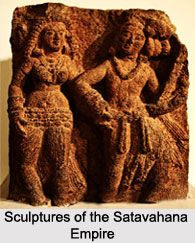 Ancient sculptures of the Satavahana Dynasty remained iconic till their rule in the 2nd century. Primarily the Satavahana style of art and sculpture was dominated by the faith of Buddhism.
Ancient sculptures of the Satavahana Dynasty remained iconic till their rule in the 2nd century. Primarily the Satavahana style of art and sculpture was dominated by the faith of Buddhism.
Various schools of sculptures flourished under the patronage of the Satavahana rulers. The Amravati School of sculpture came to the forefront as one of the most popular styles of Buddhist art. The sculptures here show some of the traces of the influence of the Gandhara Amaravati stupa and the Mathura schools to some extent.
History of Ancient Sculptures of the Satavahana Empire
The earliest Sculpture of the Satavahana Empire is the Bhaja Vihara cave which marks the beginning of sculptural art in around 200BC. It is generously decorated with carvings and even pillars have a lotus, crowned with sphinx-like mythic animals. The Satavahanas were also called the Andhra dynasty, which has led to the statement that they initiated in the Andhra region, the delta of the Krishna and Godavari rivers on the east coast, from where they moved westwards up the Godavari River.
The Satavahanas seems to commence as feudatories to the Mauryan Empire. They seem to have been under the rule of Emperor Ashoka. The founder of the Satavahana Empire was Simuka. Many statues and images were made all through this era. Most of the images portray scenes from the life of the Buddha. The sights depicting Buddha`s feet are worshipped mainly as an exclusive sculpture at the Amravati Stupa while at Nagarjunakonda, the sculpture depicting Buddha giving a speech, throw an enchantment of peacefulness.
Features of Ancient Sculptures of the Satavahana Empire
Lord Gautama Buddha was not represented in a human form. This was known to be a significant feature of the Satavahana sculptures. The features of Satavahana sculptures are also found in the sculpture of Nagarjunakonda. At Nagarjunakonda the sculptural tradition of Amaravati seems to continue. Here too, the Buddhist themes dominate the entire picture of artistic creations. Episodes from Gautama Buddha`s life have been transferred on stone. But the outstanding example of the sculpture of that ages and art of Satavahanas is the depiction of the Enlightened Buddha. The erotic sculptures are less in numbers but can be marked with their presence. The images were characterized by vigour, activity and grace.
The sculpture of Karle Chaitya is another example of the magnificence of the Satavahana architecture. The hall is more than 124 feet long, 46 feet broad and 46 feet high. It also marked with construction of the garbhagriha, the pradakshinapatha and the mandapa. Here, along with the doorway, even the elegant chaitya window, encompassing the woodwork of sculptures has remained till today. Sculpture of Kanehri has also been modelled on the particular style in which other Satavahana sculptures have been carved out.
The famous sculptures at Ajanta Caves also reflect the features of Satavahana art and architecture. The glory of the Satavahanas is, thus, rightly reflected in the tradition of art and architecture. In fact in many famous places in Andhra Pradesh like Goli, Jaggayapeta, Ghantasala, Bhattiprolu, Amaravati and Nagarjunakonda the remains of Satavahana sculptures have been discovered. A large number of Stupas had also been constructed under the regime of the Satavahanara rulers. The Bhattiprolu stupa, is a renowned sculptural beauty of the Satavahanas, which is engraved inscriptions in the Brahmi script, which is said to be closely associated to the Balinese, Burmese, Javanese, Thai and Indian Tamil and Telugu scripts.
Some more sculptures of the Satavahana Empire existed specifically are Dvarapala, Gajalaksmi, Shalabhanjikas, Royal Procession, Decorative pillar etc.



